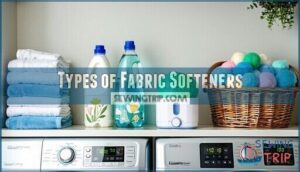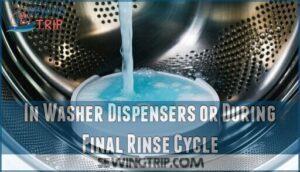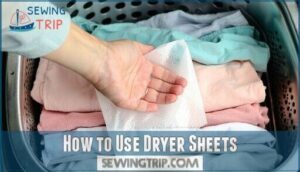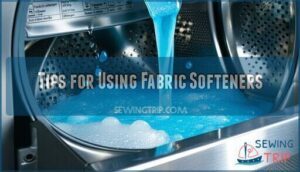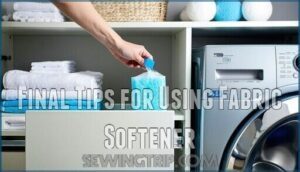This site is supported by our readers. We may earn a commission, at no cost to you, if you purchase through links.
 If you’re wondering when do you add fabric softener to the wash, aim for the rinse cycle, not the wash cycle.
If you’re wondering when do you add fabric softener to the wash, aim for the rinse cycle, not the wash cycle.
If you add it too early, the detergent can wash away the softener’s magic before it even gets started.
Most modern washers have a special compartment for fabric softener—just fill it up and let the machine handle the timing.
If yours doesn’t, wait until the rinse cycle kicks in, then pour it in.
Think of it as the final touch, like icing on a cake.
There’s more to know about softener types and tricks for fresher laundry ahead.
Table Of Contents
- Key Takeaways
- Benefits of Using Fabric Softener
- When to Use Fabric Softener in The Wash
- Types of Fabric Softeners
- How to Use Liquid Fabric Softener
- How to Use Fabric Softener Dispenser Ball
- How to Use Dryer Sheets
- How to Use Dryer Balls
- Tips for Using Fabric Softeners
- Final Tips for Using Fabric Softener
- Frequently Asked Questions (FAQs)
- Conclusion
Key Takeaways
- Always add fabric softener during the rinse cycle, not the wash, so it coats your clothes instead of rinsing away.
- Use your washer’s softener dispenser if available; otherwise, pour softener into the water during the rinse, never directly on clothes.
- Skip fabric softener for towels, athletic wear, or water-repellent fabrics to keep their special properties intact.
- Clean your washer’s dispenser monthly to prevent residue build-up and keep your laundry fresh.
Benefits of Using Fabric Softener
You’ll discover that fabric softener offers several practical benefits that make your laundry routine more effective and enjoyable.
From reducing static cling to extending the life of your clothes, understanding these advantages helps you make informed decisions about when and how to use this laundry product, which can lead to a more enjoyable laundry experience.
Softens Fabric and Adds Pleasant Aroma
A fresh towel straight from the dryer is hard to beat—thanks to fabric softener.
Nothing beats that perfect softness and fresh scent from your favorite fabric softener.
When you add it at the right time, usually during the final rinse, you boost Fiber Comfort and Softness Level.
Choose a scent strength you like, as Aroma Duration lingers.
Using a softener dispenser guarantees even distribution and avoids residue effects, maximizing fabric softener benefits.
Prevents Wrinkles and Static
Static cling causes frustration, especially when clothes stick together or spark.
Using fabric softener at the right fabric softener timing—specifically during the rinse cycle—helps reduce static electricity and wrinkles.
Fiber lubrication benefits make clothes smoother, while softener sheet alternatives or dryer ball effectiveness can also help.
Always add softener in the washing machine during the fabric softener cycle for best wrinkle reduction methods.
Reduces Wear and Tear on Clothing
After tackling wrinkles and static, let’s talk about keeping your favorite clothes looking new.
Fabric softener’s Fiber Lubrication reduces friction, so fabrics glide instead of rub.
This means less Pilling Prevention, Color Preservation, and Stretch Reduction.
One key benefit is that it helps to reduce static cling, making clothes more comfortable.
Follow the right fabric softener timing and use the rinse cycle for ideal fabric care.
Here’s what you’ll notice:
- Fewer fuzz balls
- Brighter colors
- Longer-lasting shape
- Better material quality
Minimizes Bobbles and Lint Formation
Consistency is your secret weapon against bobbles and lint.
By using fabric softener at the right laundry cycle timing—specifically in the rinse cycle with a softener dispenser—you get fiber lubrication and reduced friction.
This means less pilling and static, and better fabric protection.
Here’s a quick overview:
| Benefit | When Use Softener | Result |
|---|---|---|
| Fiber Lubrication | Rinse Cycle | Pilling Prevention |
| Reduced Friction | Dispenser Use | Static Reduction |
| Fabric Protection | Timed Addition | Less Lint |
Softens Clothing in Hard Water Areas
If you’ve ever noticed your clothes feeling stiff after a wash, hard water minerals could be the culprit.
Using softener in the washing machine helps break up these deposits, leaving fabrics softer.
Try these laundry tips softener fans swear by:
- Increase dosage adjustments.
- Use the softener dispenser.
- Watch for residue buildup.
- Consider alternative softeners.
- Check softener effectiveness.
Ideal for Bed Linens and Sensitive Skin
Choosing Gentle Softeners and Hypoallergenic Options makes a real difference for sensitive skin, especially on bed linens.
Use softener in the washing machine during the rinse cycle, as this is the best time softener can coat fibers evenly.
Natural fibers benefit most, while reduced irritation is key for skin sensitivity.
Many users prefer fragrance-free, hypoallergenic options to minimize skin irritation.
Always rely on the softener dispenser use for consistent, safe results.
Enhances Laundry Routine When Used Sensibly
After caring for bed linens and sensitive skin, Sensible Softener Use makes your laundry routine even smoother.
When you use fabric softener at the best time—during the rinse cycle—you get:
- Softer, fresher clothes every wash.
- Less risk of Softener Overuse Effects or residue.
- Smart softener dispenser use for easy dilution and Residue Prevention.
Remember, moderation helps reduce Environmental Impact.
When to Use Fabric Softener in The Wash
You should add fabric softener during the rinse cycle, not the wash cycle, to guarantee it coats the fibers properly.
It’s not necessary for every load, so check your fabrics and laundry needs before each wash.
During The Rinse Cycle, Not The Wash Cycle
You add fabric softener during the rinse cycle, not the wash cycle, to maximize softener effectiveness and minimize residue.
Proper timing is key to preventing staining and ensuring dilution, making the rinse cycle the ideal time to add softener in your washing machine using a softener dispenser.
Not Necessary for Every Wash
You know the rinse cycle is the right spot for fabric softener, but it’s not a must for every laundry load. Think of fabric softener as a treat, not a daily habit.
Overuse consequences include buildup and reduced fabric lifespan. For smarter laundry tips, try this:
- Reserve fabric conditioner for delicate or favorite clothes.
- Skip it for towels and activewear.
- Use alternative methods, like dryer balls, to soften without chemicals.
- Rotate loads to save money and reduce environmental impact.
This approach keeps your laundry routine balanced and your wallet happy. You might even consider white vinegar options for a natural approach.
Types of Fabric Softeners
You can choose from several types of fabric softeners, including liquid softener, conditioner, dispenser balls, dryer sheets, and dryer balls.
Each option works differently in your laundry routine, so understanding their features helps you get the best results, and knowing how to use them effectively is key to achieving softener success in your laundry.
Liquid Fabric Softener
Liquid fabric softener goes into the softener dispenser before the rinse cycle, not the wash.
This guarantees proper dilution and prevents staining issues. Always measure the ideal amount—too much leads to residue.
Clean your dispenser often to avoid buildup. Using softener in washing machines helps with static, but swap in dryer balls now and then for residue prevention.
Consider purchasing liquid softeners to keep your fabrics in great condition.
Fabric Conditioner
Anyone looking to soften clothes and reduce wear will find a fabric conditioner handy.
It works by coating fibers, cutting down on friction and static.
Use the softener dispenser for timed release during the rinse cycle, or add softener in the washing machine as directed.
For sensitive skin or lower environmental impact, try Softener Alternatives like vinegar. Scent Preferences vary, so choose accordingly.
Fabric Softener Dispenser Ball
A fabric softener dispenser ball is a handy gadget for releasing softener at just the right time. It takes the guesswork out of softener in laundry.
Here’s what you get:
- Easy use—just fill and toss in
- Cuts waste
- Budget-friendly
- Works with most machines
- Low-maintenance, but avoid Ball staining clothes by checking water level impact and Ball material safety.
Many users find a fabric softener ball to be quite useful.
Dryer Sheets or Dryer Balls
Toss dryer sheets or dryer balls in with damp laundry before starting the dryer.
Dryer sheets use chemicals to cut static electricity and freshen clothes, while balls—often wool or plastic—soften fabric through gentle tumbling.
Many consumers now purchase dryer balls for their laundry needs.
Check out the table below to compare options:
| Feature | Dryer Sheets | Dryer Balls |
|---|---|---|
| Dryer sheet chemicals | Yes | No |
| Ball material types | N/A | Wool, Plastic |
| Static reduction effectiveness | Moderate | High |
| Reusability comparison | Single-use | Reusable |
| Environmental impact | Higher | Lower |
The key differences between dryer sheets and dryer balls include their composition, effectiveness in reducing static, and environmental impact.
The choice between these two options often depends on the consumer’s preference for reusability and concern for the environment.
How to Use Liquid Fabric Softener
You add liquid fabric softener during the rinse cycle, not the wash cycle, to help coat and protect your clothes.
Always follow the product instructions and use the washer’s dispenser or add it manually at the right time to prevent buildup and stains, ensuring you use the correct method to avoid issues with your clothes.
In Washer Dispensers or During Final Rinse Cycle
Pouring fabric softener at the right time makes a big difference.
Use the softener dispenser if your washer has one—automatic dispensers release softener during the final rinse cycle, ensuring even coverage.
There are different dispenser types, so check your manual for the right spot.
Don’t overfill; it can cause residue and clogging.
For machines without a dispenser, manual addition works—just add diluted softener directly into the water during the rinse cycle, never on clothes.
Dilution methods help with residue prevention and keep fabrics clean.
Regular dispenser maintenance stops buildup and keeps things running smoothly.
Always target the rinse cycle for best results.
Follow Product Instructions to Avoid Build-up
Following product instructions prevents residue buildup that damages fabrics and machines. Use the correct dosage specified on labels – more isn’t better. Dilution importance can’t be overstated when adding softener manually. Clean your softener dispenser monthly to prevent clogs.
Considering alternatives can help you explore chemical-free laundry solutions.
Here’s how to prevent fabric softener buildup:
- Measure precisely – Use cap markings or measuring cup for correct dosage
- Clean automatic dispenser regularly to remove sticky residue and mold
- Dilute concentrated formulas with water before adding to prevent staining
- Skip softener occasionally to let fabrics breathe and prevent accumulation
- Check laundry instructions – some fabrics don’t need softener treatment
Consider Dryer Sheets or Dryer Balls for Added Benefits
Beyond liquid fabric softener, you’ll find dryer sheets and dryer balls offer unique advantages.
Dryer sheets provide instant freshness and static reduction, while dryer balls naturally fluff fabrics and speed drying times.
These eco-friendly options reduce chemical exposure and offer long-term cost savings.
| Method | Benefits | Best For |
|---|---|---|
| Dryer Sheets | Instant scent, wrinkle reduction, static control | Synthetic fabrics, quick results |
| Dryer Balls | Chemical-free, faster drying, fabric fluffing | Natural fibers, sensitive skin |
| Liquid Softener | Deep conditioning, lasting softness, color protection | Cotton, regular laundry loads |
How to Use Fabric Softener Dispenser Ball
Using a fabric softener ball streamlines your laundry routine by automatically releasing softener during the rinse cycle. This automatic dispenser eliminates measuring and timing guesswork, making it ideal for busy households.
Here’s how to use your softener dispenser ball effectively:
- Fill the ball with liquid fabric softener according to manufacturer instructions
- Place in the washing machine drum before adding clothes
- Start your wash cycle – the ball will release softener automatically during rinse
- Remove after each load to prevent residue buildup prevention
- Clean regularly to avoid dispenser ball stains and maintain ball compatibility issues
Water level impact affects performance – low water levels can cause staining on fabrics. For alternative ball usage, consider rotating between dispenser balls and manual addition to prevent washing machine buildup.
How to Use Dryer Sheets
You place a dryer sheet on top of your laundry before starting the drying cycle, allowing it to reduce static and wrinkles as clothes tumble.
After the cycle ends, you remove the used sheet to prevent lint buildup and maintain dryer efficiency.
Add Dryer Sheet for Wrinkle Reduction
A well-placed dryer sheet tossed in with your damp laundry is key for wrinkle reduction science.
Dryer sheet usage helps smooth out wrinkles by coating fabrics, reducing static cling, and minimizing static charge as clothes tumble. The sheet material impact matters—synthetic sheets distribute softener evenly.
Looking for sheet alternative options? Wool or plastic dryer balls also reduce wrinkles and static, minus the chemicals.
Both dryer sheets and alternatives help clothes dry faster and come out less rumpled.
Remember, regular dryer cleaning keeps everything running smoothly and prevents residue buildup, ensuring your dryer sheets or alternatives work at their best.
Remove Dryer Sheet to Prevent Blockage
After you’ve tossed in a dryer sheet for wrinkle reduction, don’t forget to take it out once your load is done.
Leaving dryer sheets behind can clog the lint screen, making it harder for air to flow and raising the risk of a fire hazard.
Sheet residue effects can build up quickly, so always check the lint trap after each cycle.
This simple habit supports safe dryer operation and keeps your machine running smoothly.
If you’re looking for dryer sheet alternatives, consider wool dryer balls, which won’t leave residue or cause lint screen blockage.
Similarly, using quality thread is important to avoid thread snags.
How to Use Dryer Balls
You can use dryer balls as an alternative to dryer sheets, and they’re easy to add to your wash.
By using 2-3 dryer balls, you’ll reduce static and help your clothes dry faster, making them a great option for your laundry routine.
Add Dryer Balls for Reduced Static and Faster Drying
After learning about dryer sheets, let’s talk dryer balls. You just add a few to your wet laundry before starting the dryer.
Wool dryer balls, a popular natural fiber option, help separate clothes, letting hot air move freely. This reduces static cling and speeds up drying, so you spend less time waiting for that last sock.
Here’s why they’re a smart choice:
- Chemical-free static charge and static cling reduction
- Faster drying benefits and better airflow
- Fewer wrinkles for your clothes
- Cost effectiveness—dryer balls last for hundreds of loads, making them a smart choice for long-term use.
Use 2-3 Dryer Balls for Best Results
For best results, drop 2-3 dryer balls into the dryer with each load.
The material of the dryer ball—wool or rubber—matters, as both help reduce static cling and soften fabric, but wool can also add a faint scent.
Larger loads may need extra balls for even softening and static reduction.
Dryer balls last for hundreds of cycles, making them a long-term fabric softener alternative.
Different fabric types, like towels or synthetics, may react differently, so adjust ball count as needed for ideal laundry results.
Tips for Using Fabric Softeners
You need to keep your washer and dryer clean, watch for residue buildup, and choose the right fabric softener type and dispenser for your machine.
These steps help your laundry routine stay effective and prevent common problems with softener use, making it a crucial part of maintaining your laundry routine.
Clean Washer and Dryer Regularly
After tossing in those dryer balls, don’t forget your washer and dryer need regular attention, too. Residue buildup from fabric softener and dryer sheets can clog your softener dispenser and trap lint, hurting efficiency and machine lifespan.
Mold prevention is key, so keep things fresh. Here’s how:
- Scrub the washing machine drum and laundry machine dispensers monthly.
- Clean the dryer vent and lint filter for proper lint removal.
- Wipe down seals to avoid sticky gunk and mildew.
By following these steps, you can ensure your washer and dryer continue to run efficiently and effectively, which is crucial for proper lint removal and maintaining a clean and fresh laundry environment, thereby aiding in mold prevention.
Be Cautious of Residue Build-up
Residue buildup is the silent enemy of fresh laundry. If you’re not careful, fabric softener residue can clog dispensers and coat your washing machine, leading to less effective softening and unpleasant odors.
Stay ahead of Overuse consequences with these tips:
- Clean softener dispensers often
- Use proper Softener dilution
- Alternate softener and plain water rinses
- Wipe the door seal after each load
- Schedule monthly Machine cleaning
These habits help with Residue prevention and keep your laundry routine smooth.
Different Fabric Softener Types and Dispensing Options
After tackling residue build-up, it’s smart to know your options.
Liquid Softeners work well in a fabric softener dispenser or with manual dilution methods during the rinse. Powder Softeners are less common but follow similar rules.
Softener Sheets belong in the dryer, while Softener Balls and automatic dispensers handle timing for you.
Always check instructions, avoid overfilling, and keep machines clean for smoother laundry days. Avoid putting detergent in the dispenser, as it can lead to detergent residue on clothes, to ensure smoother laundry experience.
Final Tips for Using Fabric Softener
You can make the most of fabric softener by following a few important steps, especially if your machine doesn’t have a built-in dispenser.
Always pay attention to how you add softener, manage dryer sheets and balls, and check for any issues with your washer or dryer, to ensure you are using your fabric softener effectively and efficiently.
Share This Helpful Article With Others
A well-timed article share can make laundry day easier for everyone.
Use social media, email outreach, or community engagement to spread these laundry softener use tips.
Promote content on when do you add fabric softener to the wash, softener dispenser use, and softener tips.
Sharing practical advice helps others master adding softener wash for better results—knowledge is best when shared.
Manual Addition of Fabric Softener if No Dispenser
Without a fabric softener dispenser, you’ll need to time your manual addition carefully during the rinse cycle timing.
Pour the liquid directly into water pockets rather than onto clothes to guarantee proper dilution importance and avoid stains.
Here’s your step-by-step manual addition process:
- Wait for rinse cycle – Add softener only when rinse water fills the washing machine tub
- Target water pockets – Pour into areas with standing water, not directly on fabric
- Skip pre-mixing – Let the washing machine handle dilution during the cycle
- Monitor timing – Add at rinse start, not mid-cycle for best results
- Consider alternatives – Wool dryer balls work well if manual addition feels too complicated
Manual addition steps require attention to avoiding stains through proper water targeting.
Without a softener dispenser, this hands-on approach still delivers soft, fresh-smelling laundry.
Caution With Dispenser Balls and Low Water Levels
Dispenser balls work well, but they can cause staining potential if your washer uses low water levels.
Without enough water dilution, the fabric softener ball releases concentrated softener directly onto clothes, creating spots and residue buildup.
Check your machine’s water settings before using an automatic dispenser to prevent machine damage and guarantee proper ball maintenance.
Proper Loading and Removal of Dryer Sheets and Balls
Several key techniques guarantee your dryer sheets and dryer balls work effectively while protecting your laundry equipment. Proper loading prevents damage to both fabrics and your automatic dispenser system.
Follow these essential steps for superior results:
- Load wet clothes loosely – Shake out each item before placing in dryer to prevent wrinkles and allow proper airflow around your softener ball or dryer sheets
- Place dryer sheet on top – Position one sheet over clothes for even distribution and effective static cling control throughout the cycle
- Remove immediately after drying – Extract dryer sheets promptly to prevent residue on sensors and lint filter blockage that reduces efficiency
When reusing dryer balls, check the ball material impact on your specific fabrics. Natural wool balls work differently than synthetic options. Always remove dryer sheets after each cycle since leftover residue can interfere with moisture sensors and create performance issues. Proper dryer sheet disposal prevents lint buildup that affects your machine’s effectiveness.
Frequently Asked Questions (FAQs)
At what point in the wash cycle do you add fabric softener?
Think of the laundry cycle as a relay race—fabric softener waits for its baton.
You’ll add it during the rinse cycle, never the wash.
This guarantees it coats your clothes, not just gets washed away.
What is the correct way to use fabric softener?
Pour fabric softener into your machine’s designated compartment or a dispenser ball, making sure not to overfill.
Add it during the rinse cycle, never directly on clothes, and always dilute to prevent stains and residue, using complete concepts to guide the process.
Can fabric softener stain clothes if not diluted properly?
Yes, fabric softener can leave stains if you don’t dilute it properly.
It’s like pouring syrup straight on pancakes—too much in one spot leaves a mess.
Always mix it with water first to avoid streaks.
Is fabric softener safe for all washing machines?
Imagine your washing machine as a dance partner—some lead, some follow.
Most machines welcome fabric softener, but always check your manual.
Use dispensers or softener balls, and clean regularly to avoid buildup or residue issues.
How often should washing machine dispensers be cleaned?
You should clean your washing machine’s fabric softener dispenser at least once a month.
Leftover gunk can build up faster than socks disappear in the dryer, so a quick rinse keeps everything running smoothly and your clothes fresh.
What fabrics should never be treated with softener?
Skip fabric softener on athletic wear, microfiber towels, flame-resistant pajamas, water-repellent clothes, and anything with spandex.
These fabrics lose their special properties, like moisture-wicking or absorbency, and might end up feeling waxy or less effective, which can affect their overall performance and make them less effective.
Can you use fabric softener with high-efficiency washers?
Imagine this: your high-efficiency washer quietly humming, ready for that extra touch.
You can use fabric softener—just pour it into the designated compartment, not straight onto clothes, and let the machine handle perfect timing and dilution.
Conclusion
Imagine you’ve loaded the washer, everything’s ready, but wait—when do you add fabric softener to the wash? Don’t guess.
The rinse cycle is your moment. Adding it too early? You’ll lose the effect.
Dryer sheets or balls can help, but timing is everything. Keep your washer clean, follow instructions, and you’ll avoid residue or static.
Master the timing, and your laundry comes out soft, fresh, and right every time.
- https://laundrysauce.com/blogs/news/how-to-use-fabric-softener?srsltid=AfmBOoq05HkPtA6R8urZ6bOVy-3BcsKBFOPsn2XpDzggnsMAjKuyfBot
- https://www.whirlpool.com/blog/washers-and-dryers/what-is-fabric-softener.html
- https://appliancegm.com/blog/how-to-use-fabric-softener-without-a-dispenser-the-right-way/
- https://www.cleaninginstitute.org/cleaning-tips/clothes/fabric-softeners-and-enhancers-comprehensive-guide
- https://www.maytag.com/blog/washers-and-dryers/what-is-fabric-softener.html


